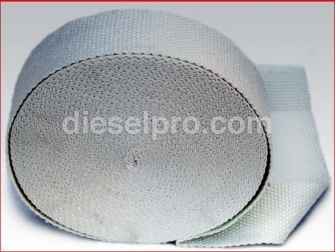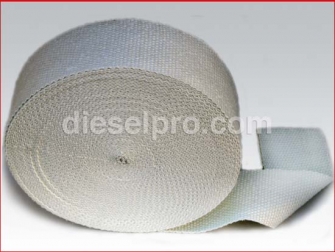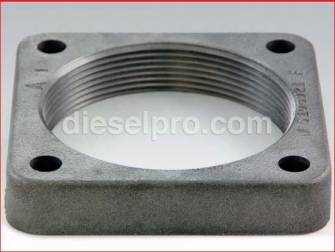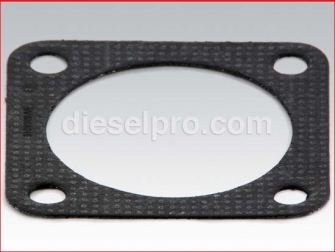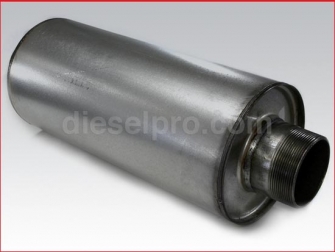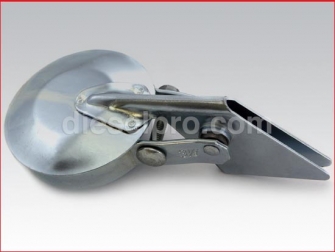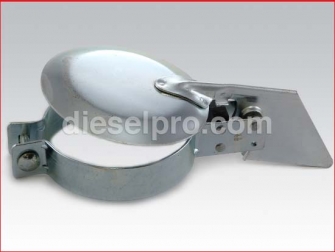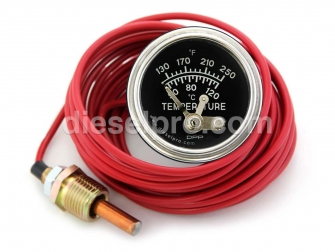Cummins QSB 5.9 Parts for Canada - Exhaust Section
 Loading...
Loading... Cummins QSB 5.9L Exhaust System Parts Catalog
The Cummins QSB 5.9L engine has earned a reputation for durability, efficiency, and adaptability across a wide range of marine and industrial applications. In any high-performance diesel engine, the exhaust system plays a critical role in performance, emissions control, and operational safety. Proper exhaust flow helps maintain combustion efficiency, controls engine temperatures, and protects surrounding equipment from heat damage.
In this catalog, we cover the essential exhaust system parts available for the Cummins QSB 5.9L, including gaskets, manifold insulation, flanges, mufflers, and related accessories. Whether you are maintaining a commercial vessel, an industrial generator set, or a heavy-duty workboat, the following components are designed to deliver long-lasting service under demanding conditions.
Understanding the QSB 5.9L Exhaust System
The exhaust system in a Cummins QSB 5.9L does more than just route gases away from the engine. It is a complex network of components that:
-
Directs exhaust flow efficiently to reduce back pressure and maintain horsepower.
-
Manages high temperatures using insulation and heat-resistant materials to protect the engine room or work environment.
-
Controls noise through mufflers and silencing devices.
-
Prevents leaks using high-quality flanges and gaskets.
-
Supports emission compliance in regulated marine or industrial zones.
By using OEM-quality components from Diesel Pro Power, operators ensure consistent performance and reduce downtime caused by exhaust leaks, overheating, or component failure.
Intake Manifold Cover Gaskets for Cummins QSB 5.9
Function and Importance
While technically part of the intake system, the intake manifold cover gasket also interacts closely with the exhaust system due to the QSB’s turbocharged design. It forms a tight seal between the intake manifold cover and the rest of the assembly, ensuring that no unfiltered air or contaminants enter the cylinders.
Benefits of Using a High-Quality Gasket
-
Maintains proper airflow for efficient combustion.
-
Prevents oil seepage and pressure loss.
-
Withstands extreme temperature fluctuations caused by exhaust system proximity.
Maintenance Tip
Always replace the intake manifold cover gasket when performing major exhaust work, especially when the turbocharger or manifold has been removed.
Manifold Insulation Tapes
High-temperature insulation is critical for both performance and safety in a marine or industrial engine room. Diesel Pro Power offers manifold insulation tapes in different widths to match your installation requirements.
3-Inch Wide Insulation Tape
-
Dimensions: 3 inches wide, 100 feet long, 1/8 inch thick.
-
Application: Ideal for wrapping smaller diameter manifold pipes, turbo outlet piping, or tight bends.
-
Benefits: Reduces heat radiation, protects crew and surrounding equipment, and enhances turbocharger efficiency by keeping exhaust gases hotter.
4-Inch Wide Insulation Tape
-
Dimensions: 4 inches wide, 100 feet long, 1/8 inch thick.
-
Application: Best for larger manifold sections or long straight exhaust runs.
-
Benefits: Provides maximum coverage with fewer wraps, improving installation speed and reducing heat transfer more effectively.
Marine Tip: In enclosed engine rooms, exhaust insulation is not just a safety requirement—it also reduces the strain on ventilation systems by lowering ambient heat levels.
Flanges for Industrial Exhaust Manifolds
4-Inch Inside Diameter Flange
Flanges create a secure connection between exhaust sections or between the manifold and the piping. A 4-inch inside diameter flange is a common size for QSB 5.9L marine and stationary power configurations.
Key Advantages:
-
Heavy-duty construction for high-temperature environments.
-
Maintains an airtight seal when used with a proper flange gasket.
-
Resistant to warping under thermal cycling.
Gaskets for Manifold Flanges
The manifold flange gasket ensures there are no leaks at flange connections, where exhaust gases are at their hottest and most pressurized.
Features:
-
Designed to handle the high heat of diesel exhaust flow.
-
Creates a reliable seal even after repeated heating and cooling cycles.
-
Essential for preventing dangerous exhaust leaks in enclosed spaces.
Pro Tip: Always replace the flange gasket whenever a flange connection is opened during maintenance.
Mufflers for Industrial and Marine Engines
A high-quality muffler does more than reduce noise—it also contributes to back pressure regulation, which can affect engine performance.
Muffler Specifications
-
4-inch inlet and outlet with National Pipe Thread (NPT) fittings.
-
Suitable for industrial generator sets, commercial vessels, and auxiliary power units.
Benefits:
-
Durable corrosion-resistant construction.
-
Engineered to maintain optimal exhaust flow without restricting turbocharger performance.
-
Reduces noise to meet occupational safety and local regulatory requirements.
Caps for Engine Mufflers
Muffler caps prevent rain, debris, and seawater spray from entering the exhaust system when the engine is not in use.
Available Sizes:
-
3 Inch
-
3.5 Inch
-
4.5 Inch
-
5 Inch
Benefits of Muffler Caps:
-
Extends muffler and manifold lifespan by preventing internal corrosion.
-
Keeps nesting animals or insects from entering the exhaust system in off-season storage.
-
Designed for quick installation and removal.
Instrumentation for Exhaust System Monitoring
Even though gauges are not physically part of the exhaust piping, proper instrumentation ensures your Cummins QSB 5.9L exhaust system is operating within safe limits.
Available Types:
-
Mechanical gauges for straightforward, direct-reading operation.
-
Mechanical gauges with alarms for early warnings of overheating or abnormal exhaust back pressure.
-
Electrical gauges (12V & 24V) for integration into digital panels or remote monitoring systems.
Suggested Read: Additional Resources on Marine Engine Temperature Management (link placeholder).
Maintenance and Installation Best Practices
Keeping your Cummins QSB 5.9L exhaust system in optimal condition requires routine inspections and quality replacement parts.
Recommendations:
-
Inspect gaskets at every major service interval.
-
Replace insulation tape if frayed, brittle, or oil-soaked.
-
Check flanges and fasteners for signs of corrosion or loosening.
-
Clean muffler caps to ensure free movement and proper sealing.
-
Monitor exhaust temperatures regularly to detect early signs of restriction.



 Free US Calls: 1-888-433-4735
Free US Calls: 1-888-433-4735 International: 305-545-5588
International: 305-545-5588







